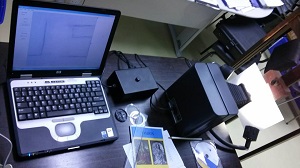Rutherford Scattering in angular momentum (RBS)
When the particle beam interacts with the sample, the nuclei of the sample have a repulsion effect on the particles of the beam due to the Coulomb interaction. This repulsion causes the ions of the incident beam to be deflected from its initial path (trajectory).
The typical trajectory deviation for RBS measures consists in equal angles of 150° to 170° relative to the direction of the incident beam (backscattering). Due to the deviation of the incident beam particles, the energy detected at the angles of 150° to 170° is less than the initial energy of the particles. This difference in energy is possible to identify the elements in the sample, because the difference depends on the ratio of the mass of the incident ions and atoms of the target.
The RBS technique also provides information about the depth distribution of elements of the target. This can be done because the energy loss is directly proportional to the length of the path traveled by the incident ion within the sample. Thus, particles that travel larger trajectories lose more energy.


